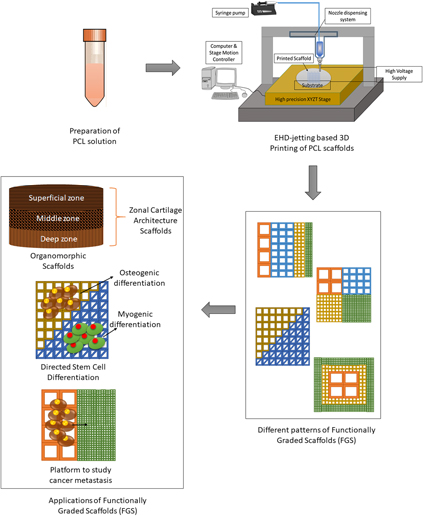Crossref Citations
This article has been cited by the following publications. This list is generated based on data provided by
Crossref.
Vijayavenkataraman, Sanjairaj
Zhang, Lei
Zhang, Shuo
Hsi Fuh, Jerry Ying
and
Lu, Wen Feng
2018.
Triply Periodic Minimal Surfaces Sheet Scaffolds for Tissue Engineering Applications: An Optimization Approach toward Biomimetic Scaffold Design.
ACS Applied Bio Materials,
Vol. 1,
Issue. 2,
p.
259.
Vijayavenkataraman, Sanjairaj
Zhang, Shuo
Thaharah, Siti
Sriram, Gopu
Lu, Wen Feng
and
Fuh, Jerry Ying Hsi
2018.
Electrohydrodynamic Jet 3D Printed Nerve Guide Conduits (NGCs) for Peripheral Nerve Injury Repair.
Polymers,
Vol. 10,
Issue. 7,
p.
753.
Choe, YoungEun
Kim, Minseong
and
Kim, GeunHyung
2019.
A One‐Step Process Using a Modified Electrohydrodynamic Process for Fabricating a Nano/Microscale Hybrid Cellulose Scaffold.
Advanced Materials Technologies,
Vol. 4,
Issue. 9,
Zhang, Shuo
Vijayavenkataraman, Sanjairaj
Chong, Geng Liang
Fuh, Jerry Ying Hsi
and
Lu, Wen Feng
2019.
Computational Design and Optimization of Nerve Guidance Conduits for Improved Mechanical Properties and Permeability.
Journal of Biomechanical Engineering,
Vol. 141,
Issue. 5,
Zhang, Xingyuan
Zhang, Lirong
Li, Yuanwei
Hua, Youlu
Li, Yangde
Li, Weirong
and
Li, Wei
2019.
Template-assisted, Sol-gel Fabrication of Biocompatible, Hierarchically Porous Hydroxyapatite Scaffolds.
Materials,
Vol. 12,
Issue. 8,
p.
1274.
Yang, Gi Hoon
Lee, JiUn
and
Kim, GeunHyung
2019.
The fabrication of uniaxially aligned micro-textured polycaprolactone struts and application for skeletal muscle tissue regeneration.
Biofabrication,
Vol. 11,
Issue. 2,
p.
025005.
Abbasi, Naghmeh
Abdal-hay, Abdalla
Hamlet, Stephen
Graham, Elizabeth
and
Ivanovski, Saso
2019.
Effects of Gradient and Offset Architectures on the Mechanical and Biological Properties of 3-D Melt Electrowritten (MEW) Scaffolds.
ACS Biomaterials Science & Engineering,
Vol. 5,
Issue. 7,
p.
3448.
Jiang, Qifeng
Zaïri, Fahmi
Fréderix, Caroline
Yan, Zhu
Derrouiche, Amil
Qu, Zhengwei
Liu, Xiaobing
and
Zaïri, Fahed
2019.
Biomechanical response of a novel intervertebral disc prosthesis using functionally graded polymers: A finite element study.
Journal of the Mechanical Behavior of Biomedical Materials,
Vol. 94,
Issue. ,
p.
288.
Chocholata, Petra
Kulda, Vlastimil
and
Babuska, Vaclav
2019.
Fabrication of Scaffolds for Bone-Tissue Regeneration.
Materials,
Vol. 12,
Issue. 4,
p.
568.
Roi, Alexandra
Ardelean, Lavinia Cosmina
Roi, Ciprian Ioan
Boia, Eugen-Radu
Boia, Simina
and
Rusu, Laura-Cristina
2019.
Oral Bone Tissue Engineering: Advanced Biomaterials for Cell Adhesion, Proliferation and Differentiation.
Materials,
Vol. 12,
Issue. 14,
p.
2296.
Teoh, Jia Heng
Thamizhchelvan, Anbu Mozhi
Davoodi, Pooya
Ramasamy, Srinivas
Vijayavenkataraman, Sanjairaj
Yang, Qiaoyun
Dicolandrea, Teresa
Zhao, Helen
Fuh, Jerry Y.H.
Liou, Yih-Cherng
and
Wang, Chi-Hwa
2019.
Investigation of the application of a Taylor-Couette bioreactor in the post-processing of bioprinted human dermal tissue.
Biochemical Engineering Journal,
Vol. 151,
Issue. ,
p.
107317.
Wang, Yichun
Bahng, Joong Hwan
and
Kotov, Nicholas A.
2019.
Three-dimensional biomimetic scaffolds for hepatic differentiation of size-controlled embryoid bodies.
Journal of Materials Research,
Vol. 34,
Issue. 08,
p.
1371.
Zhang, Shuo
Vijayavenkataraman, Sanjairaj
Lu, Wen Feng
and
Fuh, Jerry Y H
2019.
A review on the use of computational methods to characterize, design, and optimize tissue engineering scaffolds, with a potential in 3D printing fabrication.
Journal of Biomedical Materials Research Part B: Applied Biomaterials,
Vol. 107,
Issue. 5,
p.
1329.
Paxton, Naomi C.
Lanaro, Matthew
Bo, Arixin
Crooks, Nathan
Ross, Maureen T.
Green, Nicholas
Tetsworth, Kevin
Allenby, Mark C.
Gu, YuanTong
Wong, Cynthia S.
Powell, Sean K.
and
Woodruff, Maria A.
2020.
Design tools for patient specific and highly controlled melt electrowritten scaffolds.
Journal of the Mechanical Behavior of Biomedical Materials,
Vol. 105,
Issue. ,
p.
103695.
Choe, Young Eun
and
Kim, Geun Hyung
2020.
A PCL/cellulose coil-shaped scaffold via a modified electrohydrodynamic jetting process.
Virtual and Physical Prototyping,
Vol. 15,
Issue. 4,
p.
403.
Zhang, Pengfei
Wang, Zongxing
Li, Junru
Li, Xinlin
and
Cheng, Lianjun
2020.
From materials to devices using fused deposition modeling: A state-of-art review.
Nanotechnology Reviews,
Vol. 9,
Issue. 1,
p.
1594.
Liu, Sui‐Hong
Zhang, Hai‐Guang
Hu, Qing‐Xi
Wang, Ben
Li, Shuai
and
Zhang, Chuck
2020.
Development and Evaluation of Biomimetic 3D Coated Composite Scaffold for Application as Skin Substitutes.
Macromolecular Materials and Engineering,
Vol. 305,
Issue. 3,
Rahmati, M.
Blaker, J.J.
Lyngstadaas, S.P.
Mano, J.F.
and
Haugen, H.J.
2020.
Designing multigradient biomaterials for skin regeneration.
Materials Today Advances,
Vol. 5,
Issue. ,
p.
100051.
Vijayavenkataraman, Sanjairaj
Kuan, Lai Yee
and
Lu, Wen Feng
2020.
3D-printed ceramic triply periodic minimal surface structures for design of functionally graded bone implants.
Materials & Design,
Vol. 191,
Issue. ,
p.
108602.
Markandan, Kalaimani
Lim, Ruijing
Kumar Kanaujia, Pawan
Seetoh, Ian
bin Mohd Rosdi, Muhammad Raziq
Tey, Zhi Huey
Goh, Jun Seng
Lam, Yee Cheong
and
Lai, Changquan
2020.
Additive manufacturing of composite materials and functionally graded structures using selective heat melting technique.
Journal of Materials Science & Technology,
Vol. 47,
Issue. ,
p.
243.


